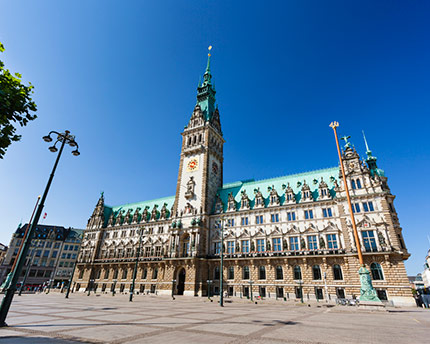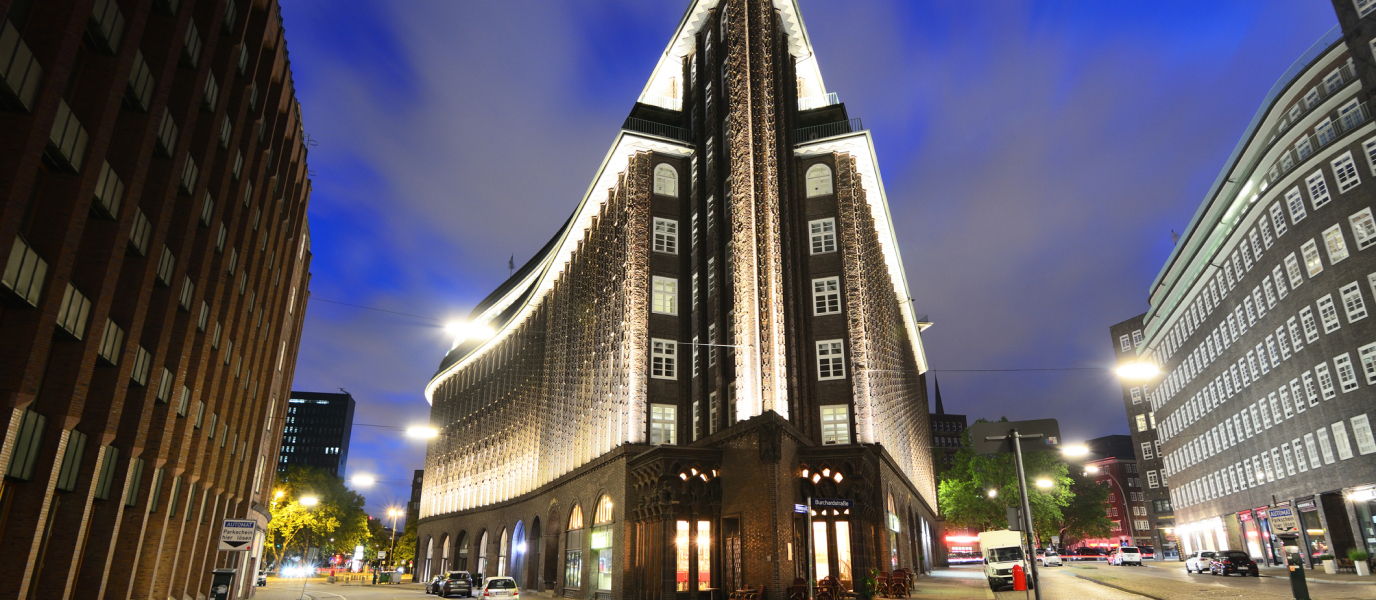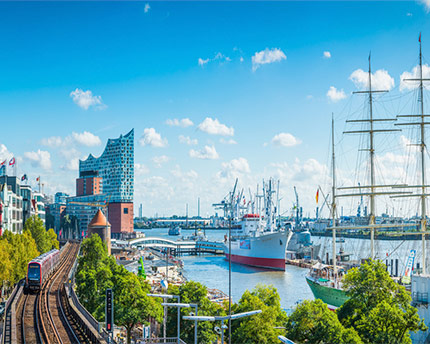With its fantastic structure, the Hamburg City Hall may well become your favourite building in the city and one of the most beautiful city halls you’ve ever seen. It’s definitely a must-see on any itinerary in this German city. In Hamburg’s historic city centre, you’ll find a number of 17th century residential buildings, as well as offices, pretty squares, and charming spots. Don’t be satisfied with just the architectural sights of the old town, but also visit the amazing harbour, which has been bustling with activity for centuries. Nearby is the Speicherstadt or warehouse district, with beautiful red brick buildings, which was accessed via the canals to unload goods, and the amazing Elbphilharmonie, where you can go to enjoy a concert or simply take a guided tour.
And as Hamburg’s nightlife is very lively, a visit to the St. Pauli district, where there’s no shortage of bars and restaurants, or to the most lively mile, the Reeperbahn, is a must. But let’s go back to the City Hall, which we’ll discuss at length below; its history, its architecture, and its beautiful interiors.
History of the Hamburg City Hall
The current Hamburg City Hall (or Rathaus) took over from an earlier city hall in Alsterhafen, which was in operation and marked the economic and political centre until 1842. Unfortunately, the first one was destroyed by fire, and after a brief period, construction of the new one began in 1886. It cost around 80 million euros and was inaugurated in 1897. As a curious fact, after the Second World War, a number of celebrities visited it to admire its beauty, including Queen Elizabeth II.
Today, the new City Hall is the official seat of the Senate and Parliament and has a prime location, with the Market Square in front of it, the Hamburg Stock Exchange behind it, and the train station very close by.
What it looks like architecturally
The Hamburg City Hall was designed by a group of seven architects called the “Rathausbaumeisterbund”, who succeeded in building it between 1884 and 1897. Martin Haller was in charge of the project. The building’s striking historical nature, with a touch of Renaissance, Gothic, and Baroque styles, reflects the prosperity of the period in which it was built, when the German Empire had just been created after the defeat of France. The dimensions of the building are astonishing, with a floor area of 17,000 m2 (excluding the restaurant) and a 112-metre-high tower that requires 436 steps to reach its highest point. A total of 647 rooms were created in this building (six more than in Buckingham Palace).
Look at the façade, with a curious balcony crowned by a mosaic depicting the goddess Hammonia, patron saint of the city, and 20 statues of emperors. If you go to the main gate, you can read: “The freedom won by ancestors must be preserved with dignity by their descendants.” The gate has a wrought-iron lattice leading to the City Hall, which is supported by 16 sandstone columns with 68 portraits of distinguished citizens of the city. The staircase doesn’t go unnoticed either; it was made of marble from Sardinia and is designed to show the life of man.
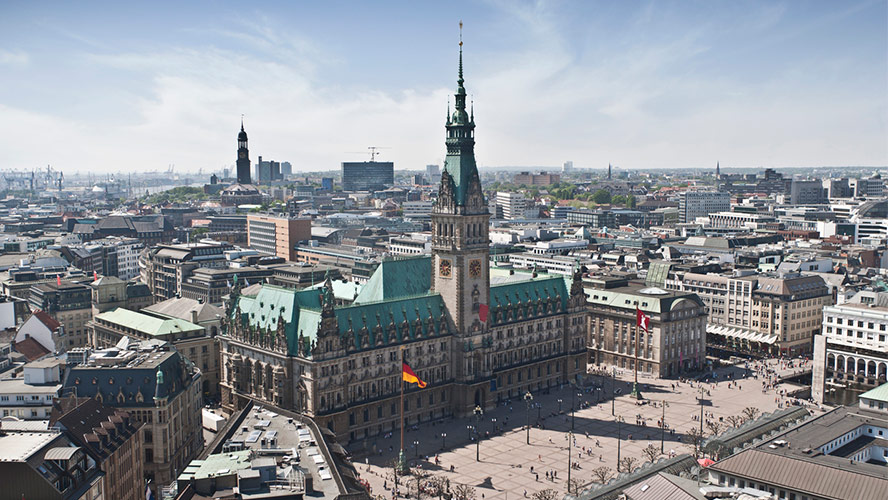
Interiors
If you think the outside of the City Hall is beautiful, wait until you see the inside. There’s a freely accessible courtyard that you can easily reach to see the Hygieia fountain, which has a bronze female figure representing health and that serves as a reminder of the last cholera epidemic. Other interesting places are the lobby, which is often used as an exhibition and concert hall, and the Emperor’s Hall on the first floor. This room is named after Wilhelm II and serves as a space for receptions. Another meeting place is the Mayor’s Hall, which is smaller but also used for meetings and for handing out the city’s Golden Book to high ranking dignitaries. We can’t forget the Ballroom, with its almost 50 metres in length, a beautiful coffered ceiling and large murals, and the Music Gallery with its beautiful marble columns.
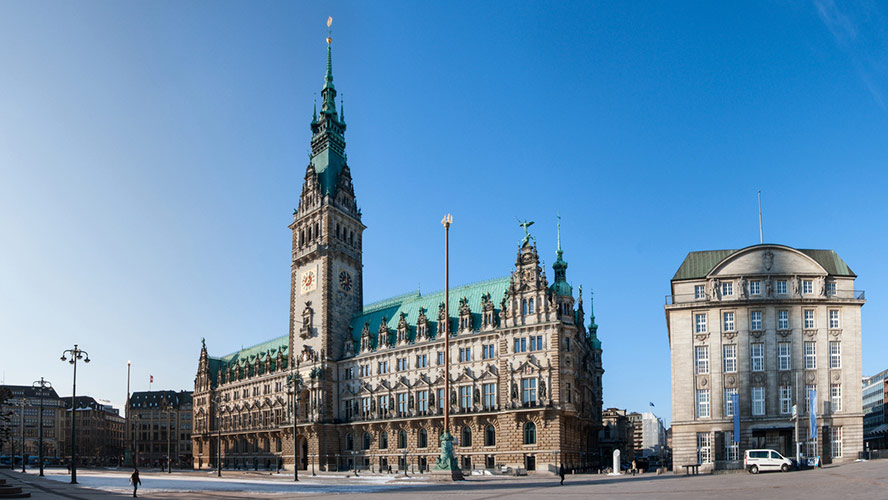
If you go to the left wing of the City Hall, you’ll find the Parliament, where the 121 representatives are located. A curious detail is that the Senate has no windows so that the politicians don’t get distracted during their work, with light entering through a glass ceiling.
Guided tours are available in German, English, and French, so we recommend you make the most of the opportunity.
Where to stay in Hamburg
In a modern and dynamic city like Hamburg, it’s best to choose a hotel that’s central and up to your standards. One suggestion that we love is the Barceló Hamburg, a four-star hotel with an urban character and avant-garde decoration whose interior design will win you over. Its 193 rooms are B-rooms, i.e. ultra-comfortable, and are divided into different categories such as Superior, Deluxe, Suite, and Junior Suite. Any of them is the perfect place to take a break from the hustle and bustle of the city.
The gastronomic offer of this Hamburg hotel stands out, as it has an à la carte restaurant with a buffet option and a bar in the lobby. Not to forget, a nice terrace where you can enjoy an aperitif with an excellent view of Hamburg. Book an evening for dinner at the 1700 Winery Bar & Restaurant because it’s well worth it. For sport and relaxation, you’ll find a gym and a spa. If you’re on a business trip, you can book one of the meeting and event rooms.





























































